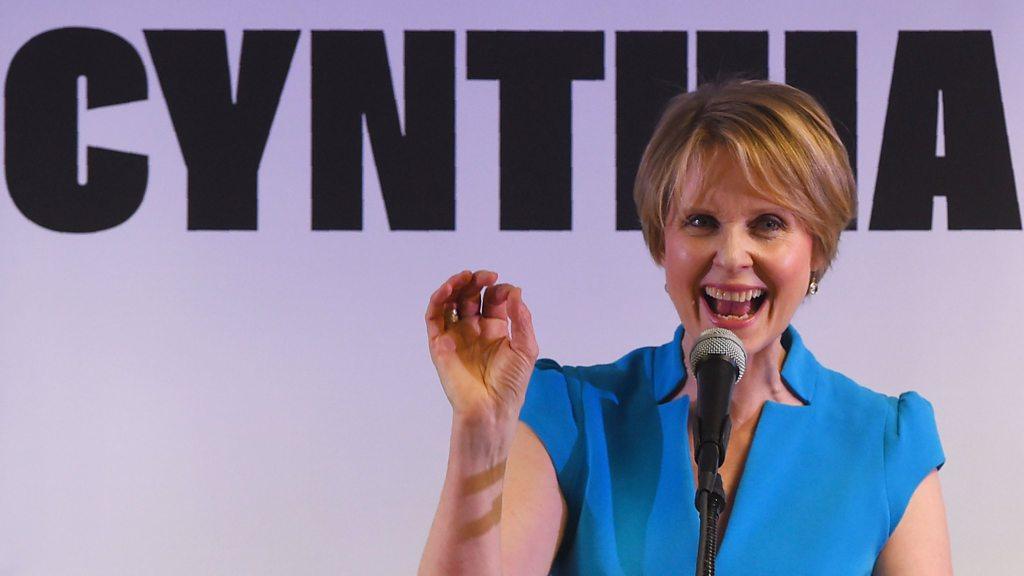Cuomo-Nixon debate: Can a room temperature really be sexist?
- Published

A debate between the Governor of New York and his challenger Cynthia Nixon has ignited a discussion about "sexist" temperatures
Can a room temperature be sexist?
The question may sound bizarre, but it's taken off on social media ahead of a debate between New York Governor Andrew Cuomo, who is seeking a third term, and Sex and the City actress Cynthia Nixon - his challenger for the Democratic nomination.
Ms Nixon has one chance to go head-to-head with Mr Cuomo, and her team fear she could be disadvantaged by freezing temperatures at the venue.
So is it just a diva demand, or part of a wider problem where women are left chilly in the workplace?
Here's how the heated discussion got started...
'Notoriously sexist temperature'
Governor Cuomo supposedly favours Arctic conditions when making public appearances. It's sufficiently bad that the New York Times once headlined an article, "Going to an Event Featuring Cuomo? Take a Coat, or Maybe a Blanket".
Keen to avoid the Big Freeze, Ms Nixon's team emailed organisers to ask that the room be heated to 76F (24C) on Wednesday night.
Strategist Rebecca Katz wrote that working conditions are "notoriously sexist when it comes to room temperature, so we just want to make sure we're all on the same page here".
When news of the request emerged, thermostat warriors lined up on both sides of the argument, with many agreeing that public spaces are "too cold" by women's standards.
"I'm sitting here in my work Snuggie wondering if this is actually the opening salvo of the revolution," wrote Washington Post columnist Monica Hesse.
Allow X content?
This article contains content provided by X. We ask for your permission before anything is loaded, as they may be using cookies and other technologies. You may want to read X’s cookie policy, external and privacy policy, external before accepting. To view this content choose ‘accept and continue’.
"At one place where I worked, I would get ready in the morning, put on a presentable outfit, and then wonder why I bothered after I got to the office and threw on my pilly old fleece zip-up to keep warm," agreed Lauren Sieben.
Iowa University Professor Kerry Howley tweeted (tongue-in-cheek) that she had "**never** felt more invested in a political debate", adding: "49% of Americans control 100% of the office thermostats. Don't engage me unless you're willing to argue at 79 degrees."
Some women disagreed, of course. Or as tweeter Katie Kearns put it: "Every woman in menopause just sweated all over you."
Politico reporter Dan Goldberg argued that there isn't a male conspiracy when it comes to temperature control, writing: "Why can't we say that men and women by and large dress differently and have different preferences??? NOT everything is sexist."
As the New York Times pointed out, however, there is some scientific basis for saying temperatures are rigged to keep men comfortable.
A 2015 study published in the journal Nature Climate Change found that most office buildings still set their temperatures based on men's metabolic rates, external. It concluded that the average comfortable level for men is about 72F, but women prefer a balmier 77.
Though Mr Cuomo's campaign declared that "unlike Cynthia Nixon, the governor has more important things to focus on than the temperature of a room", his senior aide Melissa DeRosa still weighed in online with a picture of the governor's dog lying in a pool of ice.
Allow X content?
This article contains content provided by X. We ask for your permission before anything is loaded, as they may be using cookies and other technologies. You may want to read X’s cookie policy, external and privacy policy, external before accepting. To view this content choose ‘accept and continue’.
L. Joy Williams, an adviser to Ms Nixon, hinted that her side had deliberately gone in with a higher number than they wanted, tweeting: "Maybe you say 76 degrees and get 65 degrees instead of freezing at 50."
So will the governor be feeling the heat on Wednesday, or will his challenger be left out in the cold?
Only time (and Twitter) will tell...
Cynthia Nixon held her first campaign rally in Brooklyn
- Published21 March 2018

- Published19 March 2018

- Published21 March 2018
